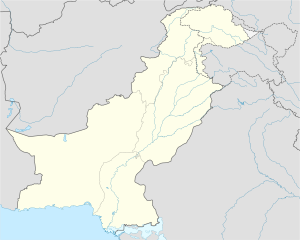An editor has nominated this article for deletion. You are welcome to participate in the deletion discussion, which will decide whether or not to retain it. |
| First Battle of Lahore | |||||||
|---|---|---|---|---|---|---|---|
| Part of
Afghan–Sikh Wars and Afghan-Maratha War | |||||||
| |||||||
| Belligerents | |||||||
|
|
| ||||||
| Commanders and leaders | |||||||
|
|
| ||||||
Lahore Fort | |||||||
Ahmad Shah Durrani raided India for the fifth time in 1759, initiating a series of conflicts with the Marathas and Sikhs. The Pashtuns, preparing for armed struggle, quickly advanced into Punjab, capturing a Maratha garrison at Peshawar and later overrunning Attock. General Jahan Khan played a key role in the advance but was met with resistance from the Marathas and their Sikh allies, led by Sabaji Shinde and the armies of the Sukerchakia and Ahluwalia Misls. In a fierce battle, the combined forces of the Marathas and Sikhs defeated the Afghans, killing 2,000 and wounding Jahan Khan. Despite being outnumbered, Sabaji managed to defend Lahore and inflicted a severe defeat on Jahan Khan, who retreated to Peshawar. This defeat angered Ahmad Shah Durrani and prompted him to take action.
Meanwhile, Ahmad Shah's administrative setup in Punjab was unstable, with Sirhind governed by Zain Khan and Lahore overseen by Sarbuland Khan, who remained at Jalandhar. Ahmad Shah's focus on preparing for his confrontation with the Marathas meant Punjab descended into disorder. From October 1759 to March 1761, the Sikhs, led by Jassa Singh Ahluwalia and other misldars, took advantage of the situation and succeeded in controlling Lahore's suburbs and surrounding areas. They built mud forts and fortalices in strategic locations, capturing Rustam Khan, governor of Chahar Mahals, and his assistant, Miskin. To avoid further conflict, the governor of Lahore paid the Sikhs Rs. 30,000, which they accepted and retreated.
Background
Ahmad Shah Durrani raided India for the fifth time in 1759. The Pashtuns began to organize themselves for armed struggle against the Marathas. The Pashtuns had no time to pass information to Kabul for help. General Jahan Khan advanced and captured a Maratha garrison at Peshawar. Then, the invaders overran Attock. [1] [2]This happened at the same time as Dattaji Sindhia was persuading Najib Khan to build a bridge of boats on the Ganges. Abdali Shah stationed himself in Peshawar, ready to support Jahan Khan's advance into Punjab.The Peshwa had made no permanent arrangements for holding the Punjab. Sabaji Sindia was a temporary caretaker with only a small force, making it challenging to defend a vast territory. Jahan Khan swiftly eliminated many scattered Maratha outposts in the province and appeared before Lahore in August. [3] [4]
Battle
Meanwhile, Sabaji Shinde retreated and reached Lahore with fresh troops and a large number of Sikh army of the Sukerchakia and Ahluwalia Misls. In the fierce battle, the Afghans were defeated by the combined forces of the Marathas and the Sukerchakia and Ahluwalia Misls. killing 2,000 Afghans and wounding Jahan Khan. [1] [2] [3] [4]Despite being outnumbered, Sabaji defended Lahore and inflicting a crushing defeat on Jahan Khan. Jahan Khan suffered severe injuries and lost his son in the battle, forcing him to retreat to Peshawar in disarray. Abdali Shah was incensed by the defeat, prompting him to take action. [3] [4]
Aftermath
During his fifth invasion of the declining Mughal Empire, Ahmad Shah Durrani faced resistance from the Sikhs near Lahore. They fought the Afghan General Jahan Khan, defeating and wounding him. However, as Maratha General Sabaji retreated from the Punjab, the Sikhs allowed the invaders to proceed towards Delhi, culminating in Ahmad Shah Durrani's victory at the Battle of Panipat in early 1761. [5]
Abdali's administrative setup in Punjab was unstable, with Sirhind governed by Zain Khan and Lahore overseen by Sarbuland Khan, who remained at Jalandhar. Ahmad Shah's focus on preparations for his confrontation with the Marathas, the region descended into disorder. From October 1759 to March 1761, the Sikhs exploited the situation, led by Jassa Singh Ahluwalia and other misldars, including Jai Singh Kanhaya, Hari Singh Bhangi, Jassa Singh Ramgarhia, and Chharat Singh Sukkerchakkia. They planned to capture Lahore during Diwali in 1760 and succeeded in controlling Lahore's suburbs and plundering surrounding areas. [6]The Sikhs built mud forts and fortalices in strategic locations for refuge and control. In October 1760, the Sikhs captured Rustam Khan, governor of Chahar Mahals, and his assistant, Miskin. To avoid further plundering, the governor of Lahore paid the Sikhs Rs. 30,000, which they accepted and retreated. [6]
References
- ^ a b Mehta, J.L. (2005). Advanced study in the history of modern India 1707–1813. Sterling Publishers Pvt. Ltd. p. 260. ISBN 978-1-932705-54-6. Retrieved 2010-09-23.
- ^ a b Gupta, Hari Ram (2021-06-13). Marathas And Panipat. Panjab University, 1961.
- ^ a b c Narayan, Jagadish (1976). A Study Of Eighteenth Century India Vol. 1. p. 343.
- ^ a b c Sardesai, Govind Sakharam (2020). New History Of The Marathas (3 Vols. Set). Munshiram Manoharlal Publishers Pvt. Limited. pp. Vol.2, pg- 402. ISBN 978-81-215-0065-4.
- ^ Jaques, Tony (2007). Dictionary of Battles and Sieges: A-E. Greenwood Press. p. 562. ISBN 978-0-313-33537-2.
- ^ a b Narayan, Jagadish (1976). A Study Of Eighteenth Century India Vol. 1. pp. 343–344.
